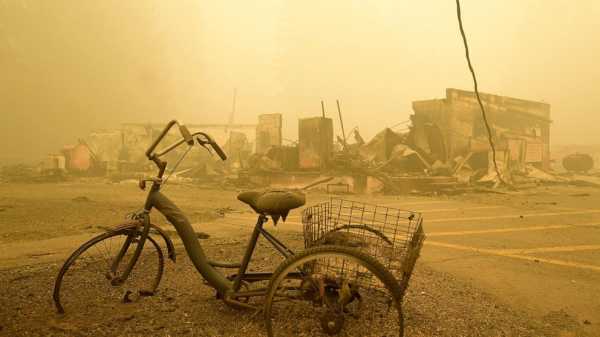
PORTLAND, Ore. — A trial connected to a $1.6 billion class action lawsuit against utility PacifiCorp over the catastrophic Labor Day 2020 wildfires in Oregon started Tuesday in Portland.
The fires in 2020 killed nine people, burned more than 1,875 square miles (4,856 square kilometers) in Oregon and destroyed upward of 5,000 homes and structures.
PacifiCorp is the primary defendant in litigation stemming from the fires, The Oregonian/OregonLive reported.
The Portland-based utility, Oregon’s second largest, didn’t shut off power to its 600,000 customers during the windstorm. Its lines have been implicated in multiple blazes, one of which started in its California service territory and burned into Oregon.
Jurors in the Multnomah County trial will determine PacifiCorp’s responsibility, if any, in four of those blazes: the Santiam Canyon fires east of Salem; the Echo Mountain Complex near Lincoln City; the South Obenchain fire near Eagle Point; and the Two Four Two fire near the southwest Oregon town of Chiloquin.
The lawsuit no matter the outcome is likely to reshape the way Oregon’s electric utilities respond to increasing wildfire risks amid climate change, consistent drought conditions and a spike in the average number of acres burned annually.
Nicholas Rosinia, a lawyer for the plaintiffs, asked jurors to hold PacifiCorp accountable for its failure to shut off power on Labor Day 2020.
“These fires were predictable and preventable and devastated the lives of thousands of Oregonians,” Rosinia told jurors. “They had the knowledge, they understood, and they chose to do nothing.”
Doug Dixon, an attorney representing PacifiCorp, disputed that the utility’s lines caused three of the four fires and most of the resulting damage. He told jurors that PacifiCorp had been on high alert and acted similarly to most other utilities that did not proactively cut power.
“This case is about reasonable precautions that PacifiCorp takes to provide safe, reasonably priced power,” he said. “PacifiCorp has and will continue to take its role very seriously.”
Rosinia on Tuesday told jurors that before that Labor Day, PacifiCorp had been repeatedly warned by state regulators for deficient tree-trimming and vegetation management around its power lines, The utility's employees were also told that increasingly alarming forecasts about the coming Labor Day windstorm and extreme fire danger had come from the National Weather Service days before the fires as well as a dire warning from the utility’s own contract meteorologist, he said.
Fires ignited in PacifiCorp’s Washington state service territory hours before the windstorm pushed south into Oregon, also providing ample warning of what was to come, Rosinia said.
At some point, Rosinia told jurors, a power shutoff was the only option left to the utility to prevent ignitions. But he said PacifiCorp never seriously considered it, even as employees in its Portland headquarters were receiving reports of fires burning under its power lines around the state.
Dixon, in his opening statements, said the plaintiffs were trying to blame PacifiCorp with an overly simplified, hindsight version of what happened — without context about the realities of climate change and the role that forest management has in causing and preventing wildfires.
Far from being unprepared, PacifiCorp was the first in the Pacific Northwest to develop a wildfire preparedness plan, he told jurors. PacifiCorp was the first utility to identify areas in its service territory at high risk of wildfires and roll out a plan for public safety-related power shutoffs in those areas. It also boosted spending on tree-pruning in the two years before the fire, he said.
“No utility (in Oregon) had ever initiated a public-safety power shutoff before September 2020. It is truly a measure of last resort” that comes with its own risks to public safety, he told jurors. “A public safety power shutoff is like a sledgehammer” when what utilities really need is a scalpel, he said.
Dixon said PacifiCorp employees were on high alert, but that its own forecasts showed relatively benign winds in its service territory. He said only two utilities either proactively shut off the power or left it off after the windstorm triggered a blackout in the Santiam Canyon.
PacifiCorp intends to challenge whether its power lines and the fires they ignited in the Santiam Canyon caused property damage to most of the plaintiffs in the class action suit. It blamed those damages on a lightning-caused blaze miles away that was whipped into a major conflagration amid the Labor Day winds. Dixon acknowledged that power lines did cause a one fire. But he said the company will show there is no way it could have spread beyond a very contained area.
The trial will determine PacifiCorp’s liability and any actual property damages for 17 named plaintiffs, each of whom is also seeking $3 million in non-economic damages for emotional distress and suffering. The liability finding, if any, would then apply to a larger class of about 2,400 people who had property damaged in the fires.
The trial is expected to last at least six weeks.
Sourse: abcnews.go.com






